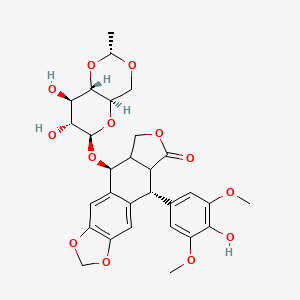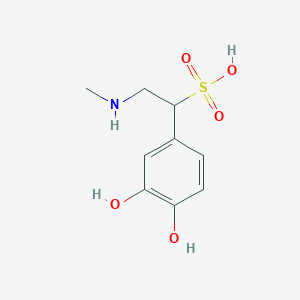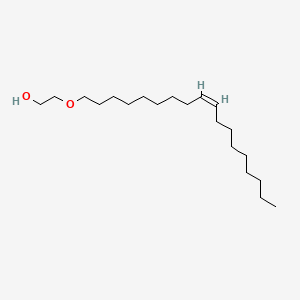
依托泊苷
描述
Etoposide is a chemotherapeutic agent used primarily in the treatment of various types of cancer, including testicular cancer, lung cancer, lymphoma, leukemia, neuroblastoma, and ovarian cancer . It is a semisynthetic derivative of podophyllotoxin, a natural product extracted from the roots and rhizomes of plants of the Podophyllum genus . Etoposide works by inhibiting the enzyme topoisomerase II, which is essential for DNA replication and cell division .
作用机制
科学研究应用
Etoposide is a semi-synthetic derivative of podophyllotoxin that inhibits topoisomerase-II, leading to DNA strand breaks and apoptosis . Since its FDA approval in 1983, etoposide has been used to treat solid and hematologic tumors, including lung cancer, germ cell tumors, and lymphoma .
Etoposide in Other Cancer Treatments
Etoposide, often in combination with other chemotherapeutic agents, is used to treat various cancers .
- Non-Hodgkin's Lymphoma Etoposide, combined with lomustine, methotrexate, and prednisone, is a first-line therapy for non-Hodgkin's lymphoma without major cardiotoxicity .
- Hodgkin's Disease Etoposide is a first-line chemotherapeutic agent combined with vincristine, chloramphenicol, and prednisolone, with a 77% response rate .
- Brain Tumors Etoposide has been observed to work against brain tumors in combination therapy with cyclophosphamide, cisplatin, vincristine, and carboplatin .
- Breast Cancer Etoposide has been explored in the management of metastatic breast cancer . A single-agent trial in untreated patients showed a response rate of approximately 15% .
- Germ Cell Tumors Adjuvant etoposide plus cisplatin for 2 cycles has demonstrated prolonged disease-specific and relapse-free survival with acceptable toxicity and lower drug costs in patients with nonseminomatous germ cell tumors .
- Choriocarcinoma Low-dose etoposide and cisplatin (EP) can be effective in treating elderly patients with choriocarcinoma .
Adverse Events and Toxicity
准备方法
化学反应分析
依托泊苷会发生几种类型的化学反应,包括:
氧化: 依托泊苷可以被氧化成其 O-醌衍生物,这在它对抗 DNA 的活性中起着重要作用.
还原: 还原反应可以将依托泊苷转化为其氢醌形式。
取代: 依托泊苷可以发生取代反应,尤其是在吡喃葡萄糖苷部分。
这些反应中常用的试剂和条件包括过氧化氢之类的氧化剂和硼氢化钠之类的还原剂。 这些反应产生的主要产物包括依托泊苷的 O-醌和氢醌衍生物 .
相似化合物的比较
依托泊苷与其他鬼臼毒素衍生物类似,例如替尼泊苷和鬼臼毒素本身。 依托泊苷在特异性抑制拓扑异构酶 II 和用于广泛的癌症治疗中是独特的 .
生物活性
Etoposide is a semisynthetic derivative of podophyllotoxin, primarily utilized as an antineoplastic agent in cancer therapy. Its biological activity is predominantly characterized by its ability to inhibit DNA topoisomerase II, leading to significant effects on DNA synthesis and cell cycle progression. This article delves into the mechanisms of action, clinical applications, and recent research findings regarding etoposide's biological activity.
Etoposide exerts its effects primarily through the following mechanisms:
- Inhibition of DNA Topoisomerase II : Etoposide forms a complex with topoisomerase II, preventing the re-ligation of DNA strands after they have been cleaved. This results in the accumulation of DNA double-strand breaks (DSBs), which can trigger apoptosis in cancer cells .
- Cell Cycle Specificity : The drug is cell cycle-dependent, affecting mainly the S and G2 phases. At high concentrations, it can induce cell lysis during mitosis, while lower concentrations inhibit cells from entering prophase .
- Activation of DNA Damage Response : Etoposide activates key proteins involved in the DNA damage response, such as ATM (Ataxia Telangiectasia Mutated) kinase, which leads to the formation of repair foci and chromosomal abnormalities if DSBs are not repaired .
Clinical Applications
Etoposide is widely used in various chemotherapy regimens for different types of cancers, particularly small-cell lung cancer (SCLC) and testicular cancer. Its effectiveness can be influenced by the scheduling of administration:
- Small-Cell Lung Cancer : In a randomized trial comparing two administration schedules, the five-day infusion regimen demonstrated an overall response rate of 89%, significantly higher than the 10% observed with a 24-hour continuous infusion schedule .
- Combination Therapies : Etoposide is often combined with other agents. For instance, in treating extensive SCLC, combinations with cisplatin have shown objective response rates ranging from 44% to 78% .
Research Findings and Case Studies
Recent studies have expanded our understanding of etoposide's biological activity beyond its traditional uses:
- Antibacterial Activity : A study explored etoposide's antibacterial properties when combined with hydroxyapatite, suggesting potential repurposing for treating infections .
- Pediatric Oncology : The OLIE trial evaluated the combination of lenvatinib, ifosfamide, and etoposide in children with high-grade osteosarcoma, showing promising outcomes .
- Toxicity Management : Research has indicated that etoposide can cause myelosuppressive toxicity; however, recent trials have focused on optimizing dosing regimens to mitigate these effects while maintaining efficacy .
Data Summary
The following table summarizes key findings from various studies on etoposide:
属性
CAS 编号 |
33419-42-0 |
|---|---|
分子式 |
C29H32O13 |
分子量 |
588.6 g/mol |
IUPAC 名称 |
(5S,5aR,8aR,9R)-5-[[(2R,4aR,6R,7S,8R,8aS)-7,8-dihydroxy-2-methyl-4,4a,6,7,8,8a-hexahydropyrano[3,2-d][1,3]dioxin-6-yl]oxy]-9-(4-hydroxy-3,5-dimethoxyphenyl)-5a,6,8a,9-tetrahydro-5H-[2]benzofuro[6,5-f][1,3]benzodioxol-8-one |
InChI |
InChI=1S/C29H32O13/c1-11-36-9-20-27(40-11)24(31)25(32)29(41-20)42-26-14-7-17-16(38-10-39-17)6-13(14)21(22-15(26)8-37-28(22)33)12-4-18(34-2)23(30)19(5-12)35-3/h4-7,11,15,20-22,24-27,29-32H,8-10H2,1-3H3/t11-,15+,20-,21-,22+,24-,25+,26-,27-,29+/m1/s1 |
InChI 键 |
VJJPUSNTGOMMGY-QBUITQBFSA-N |
杂质 |
The following impurities are limited by the requirements of The British Pharmacopoeia: 4'-carbenzoxy ethylidene lignan P, picroethylidene lignan P, alpha-ethylidene lignan P, lignan P and 4'-demethylepipodophyllotoxin. |
SMILES |
CC1OCC2C(O1)C(C(C(O2)OC3C4COC(=O)C4C(C5=CC6=C(C=C35)OCO6)C7=CC(=C(C(=C7)OC)O)OC)O)O |
手性 SMILES |
C[C@@H]1OC[C@@H]2[C@@H](O1)[C@@H]([C@@H]([C@@H](O2)O[C@H]3[C@H]4COC(=O)[C@@H]4[C@@H](C5=CC6=C(C=C35)OCO6)C7=CC(=C(C(=C7)OC)O)OC)O)O |
规范 SMILES |
CC1OCC2C(O1)C(C(C(O2)OC3C4COC(=O)C4C(C5=CC6=C(C=C35)OCO6)C7=CC(=C(C(=C7)OC)O)OC)O)O |
外观 |
White to off-white solid powder |
颜色/形态 |
Crystals from methanol |
熔点 |
236-251 °C |
Key on ui other cas no. |
33419-42-0 |
物理描述 |
Solid |
Pictograms |
Irritant; Health Hazard |
纯度 |
>98% (or refer to the Certificate of Analysis) |
保质期 |
>2 years if stored properly |
溶解度 |
Very soluble in methanol, chloroform; slightly soluble in ethanol, sparingly soluble in water. Sol in alc: approx 0.76 mg/ml Water solubility: approx 0.08 mg/mL |
储存 |
Dry, dark and at 0 - 4 C for short term (days to weeks) or -20 C for long term (months to years). |
同义词 |
alpha-D-Glucopyranosyl Isomer Etoposide Celltop Demethyl Epipodophyllotoxin Ethylidine Glucoside Eposide Eposin Eto GRY Eto-GRY Etomedac Etopos Etoposide Etoposide Pierre Fabre Etoposide Teva Etoposide, (5a alpha)-Isomer Etoposide, (5a alpha,9 alpha)-Isomer Etoposide, (5S)-Isomer Etoposide, alpha D Glucopyranosyl Isomer Etoposide, alpha-D-Glucopyranosyl Isomer Etoposido Ferrer Farma Exitop Lastet NSC 141540 NSC-141540 NSC141540 Onkoposid Riboposid Teva, Etoposide Toposar Vépéside Sandoz Vépéside-Sandoz Vepesid VP 16 VP 16 213 VP 16-213 VP 16213 VP-16 VP16 |
蒸汽压力 |
5.4X10-23 mm Hg at 25 °C /Estimated/ |
产品来源 |
United States |
Retrosynthesis Analysis
AI-Powered Synthesis Planning: Our tool employs the Template_relevance Pistachio, Template_relevance Bkms_metabolic, Template_relevance Pistachio_ringbreaker, Template_relevance Reaxys, Template_relevance Reaxys_biocatalysis model, leveraging a vast database of chemical reactions to predict feasible synthetic routes.
One-Step Synthesis Focus: Specifically designed for one-step synthesis, it provides concise and direct routes for your target compounds, streamlining the synthesis process.
Accurate Predictions: Utilizing the extensive PISTACHIO, BKMS_METABOLIC, PISTACHIO_RINGBREAKER, REAXYS, REAXYS_BIOCATALYSIS database, our tool offers high-accuracy predictions, reflecting the latest in chemical research and data.
Strategy Settings
| Precursor scoring | Relevance Heuristic |
|---|---|
| Min. plausibility | 0.01 |
| Model | Template_relevance |
| Template Set | Pistachio/Bkms_metabolic/Pistachio_ringbreaker/Reaxys/Reaxys_biocatalysis |
| Top-N result to add to graph | 6 |
Feasible Synthetic Routes
Q1: What is the primary molecular target of Etoposide?
A1: Etoposide primarily targets DNA Topoisomerase II (Topo II), an enzyme essential for DNA replication and repair. [, ] It inhibits Topo II by trapping the enzyme in a complex with cleaved DNA, ultimately leading to DNA damage and cell death. []
Q2: How does Etoposide-induced DNA damage lead to cell death?
A2: Etoposide-induced DNA damage triggers a series of downstream events, including activation of p53, a tumor suppressor protein. [] p53 can initiate cell cycle arrest, giving the cell time to repair the damage, or, if the damage is too extensive, it can trigger apoptosis (programmed cell death). [, ]
Q3: What is the molecular formula and weight of Etoposide?
A3: While this specific information is not provided in the research excerpts, Etoposide's molecular formula is C29H32O13 and it has a molecular weight of 588.56 g/mol. This information can be readily found in publicly available chemical databases.
Q4: How does Etoposide perform in liposomal formulations for pulmonary delivery?
A5: Research indicates that Etoposide can be successfully incorporated into liposomes for pulmonary delivery. Freeze-dried liposomal formulations of Etoposide, using trehalose as a cryoprotectant, demonstrated good stability in terms of particle size and drug content for up to six months when stored at both ambient and refrigerated temperatures. []
Q5: What is the role of P-glycoprotein (P-gp) in the pharmacokinetics of Etoposide?
A6: P-glycoprotein (P-gp), encoded by the ABCB1 gene, plays a significant role in the absorption, distribution, and excretion of Etoposide. [, ] It acts as a transport protein, limiting the oral uptake of Etoposide and mediating its excretion across the gut wall. []
Q6: How does the ABCB1 (C1236T) polymorphism affect Etoposide's pharmacokinetics?
A7: The ABCB1 (C1236T) polymorphism has been shown to affect the transport activity of P-glycoprotein. Research using recombinant Caco-2 cell lines, expressing either the wild-type or variant P-gp, revealed that the variant P-gp transports Etoposide to a greater extent compared to the wild-type protein. [] This suggests that individuals with the ABCB1 (C1236T) polymorphism might experience altered Etoposide pharmacokinetics and potentially different therapeutic outcomes.
Q7: What is the bioavailability of oral Etoposide?
A8: The oral bioavailability of Etoposide is highly variable, ranging from 25% to 80% among cancer patients. [] This variability can be attributed, in part, to variations in transporter expression or activity, such as P-glycoprotein (P-gp), which influences the absorption and efflux of Etoposide. [, ]
Q8: What is the relationship between Etoposide exposure and neutropenia?
A9: Studies indicate a strong correlation between exposure to the free, pharmacologically active form of Etoposide and the risk of neutropenia, a significant decrease in neutrophils, a type of white blood cell. [] The higher the exposure to free Etoposide, the greater the risk of developing neutropenia.
Q9: What is the efficacy of oral Etoposide in treating metastatic breast cancer?
A10: A pooled analysis of twelve studies investigating the use of oral Etoposide in metastatic breast cancer revealed a moderate clinical effectiveness, with a pooled response rate of 18.5% and a clinical benefit rate of 45.8%. []
Q10: What are the known mechanisms of resistance to Etoposide?
A11: Resistance to Etoposide can arise through various mechanisms, including decreased expression of Topoisomerase II (Topo II), the primary target of Etoposide. [] Other mechanisms involve the multidrug-resistant phenotypes encoded by the mdr1 and MRP (multidrug resistance-associated protein) genes. []
Q11: What are the potential long-term effects of Etoposide treatment?
A13: Etoposide treatment has been associated with an increased risk of developing secondary acute myeloid leukemia (s-AML), a serious blood cancer. [] This risk appears to be higher when Etoposide is used in combination with cyclophosphamide. The latency period for developing s-AML after Etoposide treatment is typically 1-3 years, though longer periods have been reported. []
Q12: Have nanosuspensions been explored as a potential drug delivery system for Etoposide?
A14: Yes, research has investigated the use of Etoposide-loaded bovine serum albumin (BSA) nanosuspensions for parenteral delivery. [] This approach aims to improve the delivery of Etoposide, a poorly water-soluble drug, and potentially enhance its therapeutic efficacy while minimizing side effects.
Q13: What analytical techniques are commonly used to quantify Etoposide in biological samples?
A15: High-performance liquid chromatography (HPLC) is frequently employed to quantify Etoposide in biological samples, such as plasma. [, , ] Fluorescence detection is often used in conjunction with HPLC to enhance sensitivity. []
Q14: How do transporters like ABCC2 and ABCC3 influence Etoposide pharmacokinetics?
A16: ABCC2, also known as MRP2, plays a crucial role in the hepatobiliary excretion of Etoposide. [] ABCC3 (MRP3) contributes to the elimination of Etoposide glucuronide, a metabolite of Etoposide, from the liver into the bloodstream, which is subsequently eliminated in urine. []
体外研究产品的免责声明和信息
请注意,BenchChem 上展示的所有文章和产品信息仅供信息参考。 BenchChem 上可购买的产品专为体外研究设计,这些研究在生物体外进行。体外研究,源自拉丁语 "in glass",涉及在受控实验室环境中使用细胞或组织进行的实验。重要的是要注意,这些产品没有被归类为药物或药品,他们没有得到 FDA 的批准,用于预防、治疗或治愈任何医疗状况、疾病或疾病。我们必须强调,将这些产品以任何形式引入人类或动物的身体都是法律严格禁止的。遵守这些指南对确保研究和实验的法律和道德标准的符合性至关重要。















